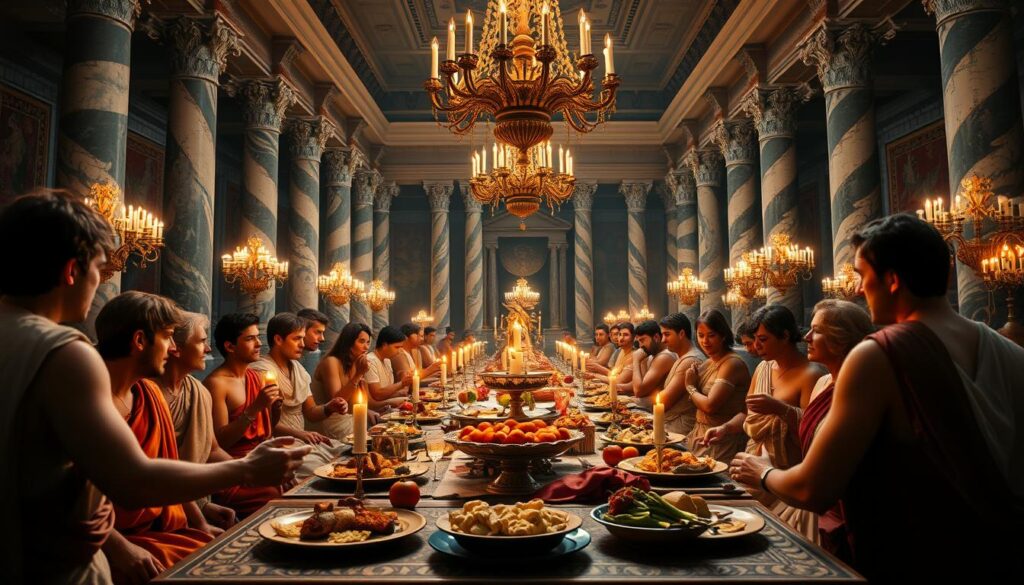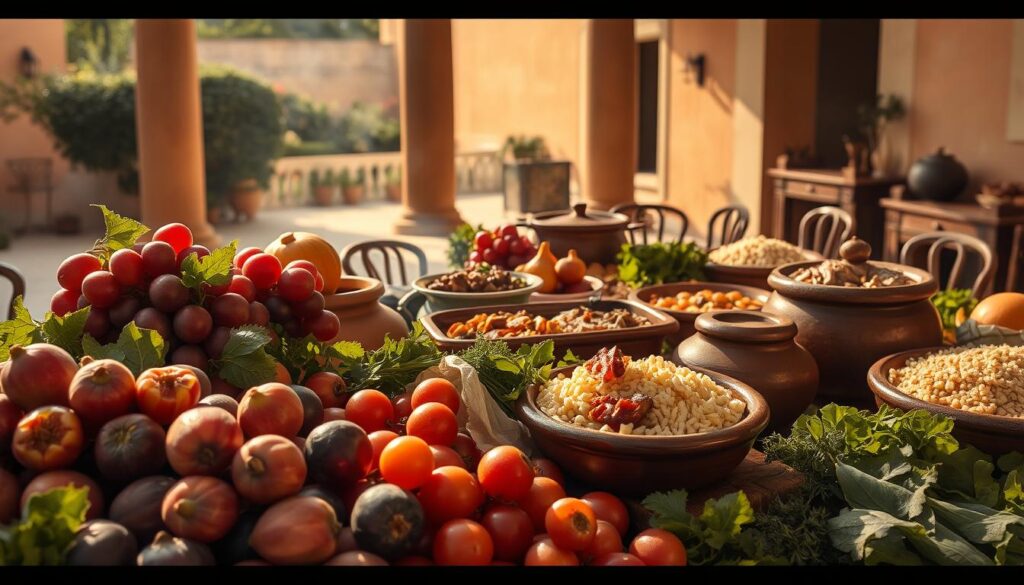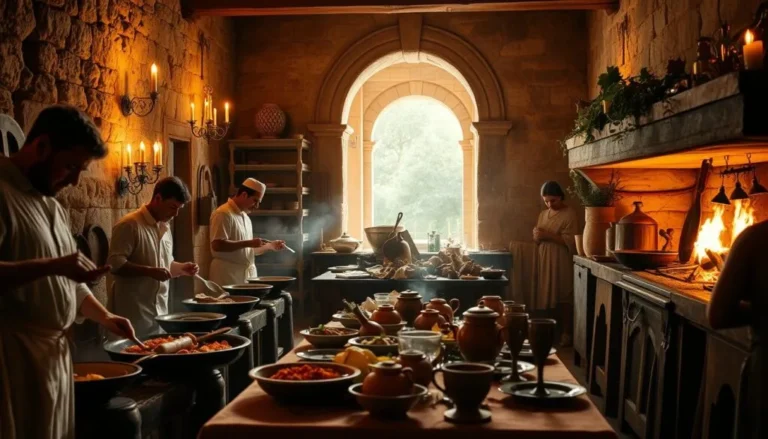When I first found old Roman recipes, I felt like I traveled back in time. The ancient world of food was more than just eating—it was a celebration of culture and creativity. It showed how the Romans turned simple ingredients into amazing dishes.
Picture walking through Rome’s busy streets, where the smell of fresh libum and sizzling meats fills the air. These recipes were not just meals; they were stories to be enjoyed. The Romans mixed Greek and Egyptian cooking styles to make dishes that lasted for centuries.
Looking into these ancient old Roman recipes, we see a world as rich and complex as the Roman Empire itself. From street foods to grand feasts, these recipes show a deep understanding of taste, technique, and culture. They still inspire chefs and food lovers today.
Key Takeaways
- Ancient Roman cooking integrated diverse cultural influences
- Recipes were more than food—they were cultural expressions
- Techniques from old Roman recipes continue to inspire modern cuisine
- Ingredients were carefully selected for maximum flavor and nutrition
- Cooking was considered an important social and artistic practice
Table of Contents
Introduction to Old Roman Cuisine
Explore the world of ancient Roman food, where meals were more than just to eat. The Roman diet was a mix of culture, economy, and geography. It created a unique food scene.
Traditional Roman dishes showed the society’s layers. Learning about their food lets us peek into their lives, social setups, and traditions.
Food’s Cultural Significance
Roman food told a lot about a person’s status. The food and cooking methods changed with social class:
- Wealthy Romans had exotic foods
- Middle-class folks had simpler meals
- Poor Romans ate basic grains and veggies
Economic and Regional Influences
The Roman Empire’s size affected food choices. Each area brought its own tastes and cooking styles to the table.
| Region | Key Ingredients | Culinary Contribution |
|---|---|---|
| Mediterranean Coast | Olives, Fish | Seafood Dishes |
| Gaul | Cheese, Wines | Advanced Fermentation |
| North Africa | Dates, Spices | Sweet and Spicy Flavors |
Cooking Techniques of Ancient Rome
Roman cooking was an art that valued simplicity and fresh ingredients. They used roasting, boiling, and baking. Each method was chosen to bring out the best in their food.
From soldiers’ simple meals to the fancy feasts of the rich, Roman food showed their advanced culture and creativity in the kitchen.
Key Ingredients in Old Roman Recipes
Exploring ancient Roman recipes shows a rich mix of culinary traditions. These traditions shaped Roman cuisine. The Romans chose ingredients carefully to make tasty and healthy meals for their empire.
Roman cooking used a wide range of ingredients. These ingredients turned simple meals into special dining experiences. Knowing these ingredients helps us understand the advanced taste of ancient Roman culture.
Grains: The Foundation of Roman Diets
Wheat and barley were key in Roman diets. They were used to make bread, porridges, and other foods. These foods gave Romans the energy they needed for their day.
- Wheat (Triticum): Primary grain for bread-making
- Barley (Hordeum): Used in porridges and less refined breads
- Emmer wheat: An ancient grain popular in Roman cuisine
Herbs and Spices: Flavoring the Roman Table
Aromatic herbs were vital in Roman cooking. They added depth and complexity to their dishes. The Romans were skilled at mixing herbs to create unique flavors.
| Herb Category | Common Herbs | Culinary Use |
|---|---|---|
| Condimenta viridia | Mint, Celery, Cilantro | Fresh aromatic seasoning |
| Condimenta moretaria | Rue, Fennel, Mint | Sophisticated herb blends |
Proteins: Diverse Sources of Nutrition
Roman diets included many protein sources. This showed their adaptability and creativity in cooking. Meat, fish, and vegetables were cooked in new ways to enhance flavor and nutrition.
- Meat: Chicken, quail, partridge, pigeon
- Fish: Prepared with garum, a fermented fish sauce
- Vegetables: Legumes, mushrooms, leafy greens
Learning about these ingredients helps us see the complexity of Roman cooking. It shows the depth of their ancient recipes.
Traditional Roman Dishes to Try
Explore the classic roman food that has lasted for centuries. The ancient Romans created a rich cuisine that still inspires today. These old roman recipes show us what life was like in one of history’s greatest civilizations.
Roman food was not just for eating; it was an art form. It celebrated local ingredients and new cooking ways. Here are some dishes that show the true taste of Roman food:
Garum: The Legendary Fermented Fish Sauce
Garum was key to Roman flavor. It was a fish sauce that made simple meals special. Made from fish guts, salt, and herbs, it’s like the fish sauce of today’s Asian foods.
- Primary ingredient in most Roman recipes
- Produced through a careful fermentation process
- Used as a universal seasoning across social classes
Moretum: A Zesty Herb Cheese Spread
Picture a fresh herb cheese spread that’s full of flavor. Moretum was a favorite snack that showed the Romans’ love for fresh herbs. It mixed garlic, herbs, and soft cheese for a tasty treat with bread.
Puls: The Humble Ancient Roman Porridge
Before pasta was famous, puls was the main grain dish in ancient Rome. This simple porridge was made from wheat or millet. It was a key food for soldiers, farmers, and everyone else. You could add beans, veggies, or a bit of meat to it.
- Primary source of carbohydrates in Roman diet
- Easy to prepare with minimal ingredients
- Nutritionally dense and filling
These dishes are more than food; they open a window into ancient Roman culture.
Ancient Roman Bread Varieties
Bread was key in Roman cuisine, feeding both the rich and the poor. Old Roman recipes show a world of bread-making beyond just food. These breads were at the heart of traditional Roman dishes, each with its own story.
The Romans turned bread-making into an art, creating techniques that lasted for centuries. Making bread was a complex task, showing the skill and hard work of Roman bakers.
Panis Quadratus: The Roman Flatbread
The Panis Quadratus is a standout in Roman bread-making. Finds in Pompeii give us a peek into this famous bread:
- Typically weighed about 1.3 kg (4 Roman libre)
- Divided into eight distinctive wedges
- Made from durum wheat or common bread wheat
- Baked at 375°F (190°C) for 60 minutes
Libum: A Simple Honey Cake
Libum was more than a sweet treat. It played a big role in Roman religious ceremonies. Made with cheese and honey, it was often given to the gods.
Cibaria: Celebratory Bread for Festivals
Festival breads united communities, making meals special. These breads showed the Romans’ creativity in making bread. They used unique ingredients and designs, making each loaf a celebration of Roman culinary art.
The bread-making process was a testament to Roman ingenuity, requiring 6 to 12 hours of careful preparation and skill.
Cooking Methods of the Romans
Ancient Roman cooking was a true art form. It used many techniques to make tasty meals. The Romans were creative, turning raw ingredients into delicious dishes through roasting, baking, boiling, and stewing.
- Roasting over open fires
- Baking in clay ovens
- Slow-cooking stews in ceramic pots
- Boiling various ingredients together
Roasting: Techniques for Meats and Vegetables
Roasting was a main cooking method for the Romans. They used spits to cook meats over flames, turning them for even cooking. Vegetables roasted with meats picked up smoky flavors.
Baking: Ancient Ovens and Their Uses
Roman bakers built clay ovens for precise temperature control. These ovens were key for baking bread and cooking complex dishes. Bread was a staple, making baking a vital skill in Roman homes.
Boiling and Stewing: Popular Cooking Methods
Boiling and stewing were common methods for hearty meals. Large pots simmered with meats, vegetables, and grains. These one-pot dishes fed families or military units.
Roman cooking was not just about sustenance, but an art form that celebrated flavor and creativity.
Feasting and Banquet Traditions
Roman culinary traditions turned dining into an art form. Banquets were grand social events that showed off a host’s wealth and status. These events were like performances, with food playing a key role in showing off social standing.

A Roman banquet followed a set plan to impress guests. People sat on lecti couches in a U-shape around a low table. This setup showed luxury and social status.
Courses of a Typical Roman Feast
- Gustatio (Appetizers): Light dishes to get the appetite going
- Olives and cheese
- Stewed apricots
- Herb cheese spread (Moretum)
- Prima Mensa (Main Course): Hearty dishes to show off cooking skills
- Parthian Chicken
- Lucanian Sausages
- Puls (Roman Porridge)
- Secunda Mensa (Dessert): Sweet treats to end the meal
- Libum (Roman Cheesecake)
- Honey-stuffed dates
- Baked pears with honey and pepper
Entertainment During lunch
Roman banquets were more than just food. They were full sensory experiences. Guests enjoyed music, poetry, games, and more between courses.
- Musical performances
- Poetry recitations
- Dice games like Tesserae
- Drinking games such as Kottabos
Wine was key at these events, often mixed with water and sweetened. The most elite gatherings featured muslin wine, a sweet drink loved by the nobility. This made dining a luxurious experience.
Influential Roman Cookbooks and Authors
Explore the world of ancient Roman cooking through their literature. Here, we find the roots of Mediterranean cuisine. It shows how food traditions shaped the region for centuries.
The key to understanding Roman cooking is De Re Coquinaria by Apicius. It’s one of the oldest cookbooks in history. It gives us a peek into how Romans cooked and what they liked to eat.
Apicius: Pioneer of Roman Culinary Documentation
Apicius was more than a cookbook writer. His work, De Re Coquinaria, is full of details on cooking, ingredients, and dining. It has about 500 recipes, showing the complexity of Roman food.
- Detailed old Roman recipes for meat and seafood preparations
- Complex sauce techniques
- Preservation methods for various ingredients
Notable Culinary Scholars of Rome
Other Roman writers also left their mark on cooking. They helped keep alive the rich food traditions that still inspire us today.
| Author | Contribution |
|---|---|
| Pliny the Elder | Documented agricultural practices and food culture |
| Columella | Wrote extensively about agricultural techniques |
The Enduring Legacy of Roman Cookbooks
Today, these old Roman recipes still excite chefs and food lovers everywhere. Experts study and adapt these ancient methods for our kitchens.
Roman cookbooks are not just recipe collections, but windows into an entire civilization’s culinary imagination.
The Role of Street Food in Ancient Rome
Street food was key in ancient Rome, offering fast and cheap meals. The city buzzed with street food, feeding thousands of people.
Ancient Romans loved quick meals from thermopolia, the ancient fast-food spots. These places were like today’s street food stalls, serving traditional dishes to busy folks.
Common Street Foods of the Time
Roman street food was full of flavors. You could find:
- Coarse bread with salty fish
- Baked cheese
- Lentil dishes
- Spicy wine
The Importance of Thermopolia
Archaeologists have found a lot about these old eateries. In Pompeii, about 80 thermopolia were found, acting as social and food centers.
| Location | Interesting Findings |
|---|---|
| Herculaneum | Three large bread ovens, multi-patron dining setup |
| Vetutius Placidus Thermopolium | Specialty of baked cheese with honey |
How Street Food Influenced Modern Eating Habits
The Roman street food scene set the stage for today’s fast food. From snacks at amphitheaters to food stands, the need for quick, tasty meals never changed.
Street food wasn’t just about food—it was a way to connect people from all walks of life.
Seasonal Dishes in Ancient Rome
Roman cooking was all about the seasons. Each season brought new flavors and ingredients. This showed how close the Romans were to their food and nature.

The Romans loved eating with the seasons long before it was trendy. Their meals changed with the year, using the freshest ingredients.
Spring Recipes: Fresh Ingredients of the Season
Spring was full of fresh veggies and herbs. The Romans enjoyed dishes like:
- Cicoria Ripassata: Sautéed chicory with garlic and peperoncino
- Fresh artichoke preparations
- Light vegetable stews with new produce
Summer Delicacies: Cool Dishes for Hot Days
Summer in Rome was hot, so meals were light and cool. Seafood, cold veggies, and chilled fruits were favorites.
- Seafood fricassee
- Cold meat platters
- Fresh fruit desserts
Winter Comfort Foods: Hearty and Filling Meals
Winter needed warm, filling meals. The Romans made stews, roasted meats, and porridges to keep warm.
- Puls (barley porridge)
- Slow-cooked meat dishes
- Rich legume-based stews
“In every season, Roman cuisine celebrated the gifts of the earth, transforming simple ingredients into extraordinary meals.” – Ancient Roman Culinary Historian
Dessert and Sweet Treats of Ancient Rome
Ancient Roman recipes show a world of sweet delights that still excite us today. Their desserts were a big part of their food culture. They mixed natural ingredients with clever cooking methods to make tasty treats.
The base of Roman desserts was honey and fresh fruits. These ingredients made simple recipes into amazing dishes. The ancient Romans knew how to make sweet treats that pleased their refined tastes.
Honey and Fruit: Natural Sweeteners of Antiquity
Honey was the main sweetener in ancient Rome. They mixed it with fruits to create unique flavors. Some common ingredients included:
- Fresh seasonal fruits
- Dried fruit preserves
- Nuts like almonds and walnuts
- Imported exotic spices
Libum: The Ancient Roman Cheesecake
Libum was a cheese dessert that’s like today’s cheesecake. It was made with ricotta cheese, eggs, and honey. This dessert was often given as a religious offering during ceremonies.
Dulcia: Banquet Sweet Delights
Roman banquets featured many sweet treats called dulcia. These desserts showed the host’s wealth and taste. The Roman food culture valued both taste and presentation in their sweets.
Exploring these ancient desserts lets us see the creativity of Roman chefs. They turned simple ingredients into incredible sweet dishes.
Roman Beverages: What Were They Drinking?
Exploring historical Roman cuisine shows us how important drinks were. They had a complex drinking culture. Their drinks reflected their social life and cooking skills.
The average Roman drank a lot of wine, about one liter a day. That’s around 104 gallons a year. Wine was a big part of their lives and culture.
Wine: The Centerpiece of Roman Dining
Romans were very smart about drinking wine. They mixed it with water to make it taste better. They used different ratios of wine to water, making it refreshing and not too strong.
- Albanum: Available in dry and sweet variations
- Falernum: High-quality white wine aged up to 20 years
- Conditum: Wine infused with honey, pepper, and seawater
Posca: The Popular Drink for Soldiers
Soldiers drank posca, a vinegar-based drink. It was made from water and sour wine. It was good for them and showed the practical side of Roman drinks.
Water and Other Refreshments
Rome had a great system for getting water. They got almost a billion liters of water every day. Besides wine and posca, they also liked mulsum, a mix of wine and honey. It showed their creativity in cooking.
Reviving Old Roman Recipes for Modern Palates
Bringing ancient Roman recipes into your kitchen is easy. You just need to know how to mix old recipes with new ingredients and cooking ways. Chefs and food lovers can dive into ancient Rome’s food history by tweaking old recipes a bit.
When you update these dishes, think about swapping ingredients and keeping the main flavors. For example, you can use anchovy paste or worcestershire sauce instead of garum. Choose fresh, local ingredients that match Roman cooking’s simplicity and seasonality. This way, you keep the recipe’s spirit alive for today’s cooks.
Try cooking like the Romans did to change your cooking game. They used slow roasting, clay pots, and lots of fresh herbs. Hosting a Roman-themed lunch party is a great way to share these unique tastes. By updating ancient Roman recipes, you’ll offer a meal that connects past and present.
Cooking is all about trying new things and having fun. Feel free to add your own twist to these old Roman recipes. Every time you cook, you get closer to ancient Rome’s food culture. Your kitchen becomes a journey through time.
FAQ
What made Roman cuisine unique compared to other ancient culinary traditions?
old Roman recipes stood out because of its wide range of ingredients and cooking methods. They used ingredients from conquered lands and made advanced sauces like garum. Their cooking techniques focused on flavor and preserving food.
How important was food in Roman social structure?
Food was key in Roman society, showing a person’s status, wealth, and culture. Banquets were grand events where hosts showed off their wealth and hospitality. They served elaborate dishes and entertainment.
What were the primary staple foods in ancient Roman diets?
Romans ate wheat, barley, grains, legumes, veggies, and bread. They also had meat and fish. Bread was a big part of every meal, no matter the class.
Were there significant regional variations in Roman cooking?
Yes, Roman cooking varied a lot by region. Coastal areas had more seafood, while inland had more farm products. Local ingredients and climate made each region’s food unique.
How did Romans preserve food without modern refrigeration?
Romans preserved food by salting, smoking, pickling, and fermenting. Garum, a fish sauce, was a key method. They also used honey, vinegar, and herbs to keep food fresh.
What cooking equipment did ancient Romans use?
Romans had clay ovens, bronze and ceramic pots, and grills. They used different pots for boiling, roasting, and baking. This showed their advanced cooking tech for the time.
How authentic are modern reconstructions of ancient Roman recipes?
Modern recipes are based on ancient texts and research. While exact replicas are hard, historians have made pretty accurate versions of Roman dishes.
What role did street food play in ancient Roman society?
Street food was vital for working-class Romans. Thermopolia offered quick, cheap meals. They had a variety of foods and drinks.
Were Roman desserts similar to modern sweets?
Roman desserts were different but had some similarities. They used honey, fruits, and nuts for sweetness. Dishes like Libum showed they enjoyed complex, flavorful desserts.
How did seasonal changes affect Roman cooking?
Seasonal changes greatly influenced Roman cooking. Spring brought fresh veggies, summer had cooling dishes, autumn had harvest recipes, and winter had warm meals. This ensured a varied diet all year.
There are no reviews yet. Be the first one to write one.

